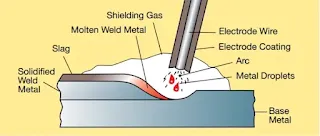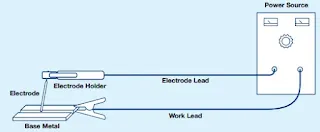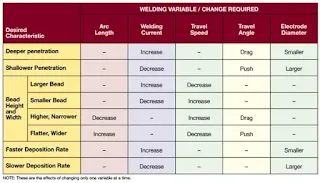Understanding Shielded Metal Arc Welding (SMAW)
Shielded Metal Arc Welding (SMAW) is a commonly used welding method across various industries. This method involves using a coated electrode that melts to permanently join metals.
The working principle of SMAW includes creating an electric arc between the electrode and the work metal, generating high heat to melt the electrode and partially the work metal.
The welding electrode plays a crucial role, with different types and specifications designed to meet various welding needs.
Electrode specifications encompass factors like coating type, diameter, and material composition. Additionally, SMAW welding variables, such as current, voltage, and welding speed, also influence the final outcome of the welding process.
Shielded Metal Arc Welding Basics
In this session, we'll delve into understanding the definition of shielded metal arc welding, explore its operational mechanism, uncover the pivotal role played by the welding electrode, delve into diverse electrode specifications, and examine the critical variables that come into play, etc.
1. Definition of SMAW
Shielded Metal Arc Welding (SMAW), also known as "stick welding," is an electric arc welding technique. In this process, welding heat is generated by an electric arc between a covered metal electrode and the workpiece. The electrode contains a filler metal surrounded by slag, acting as a protective shield during welding.
The term SMAW implies joining or adding metal to surfaces. "Shielded" signifies the elimination of air around the weld to ensure quality. In another sense, it relates to the electrode core wrapped with flux.
"Metal" refers to the electrode core, a conductor rod melting to fill the weld pool. "Arc" denotes the plasma release transforming electrical energy into heat, and "welding" indicates metal joining by fusion.
The protective measures in SMAW involve displacing air through electrode combustion gases and shielding molten metal with flux or slag. These actions prevent harmful effects on the weld pool caused by air constituents.
Related article: TIG Welding Shielding Gas: Various Types and Characteristics
2. Welding Process
Illustration: stick welding process
The principle of operation for Shielded Metal Arc Welding (SMAW) involves the transformation of electrical power into heat energy to create a welding arc. The intense heat from this arc melts a portion of both the workpiece and the electrode tip.
The welder maintains the arc length by adjusting the gap between the electrode and the weld pool. When the arc is extinguished, the molten material solidifies into a continuous metal solid.
In the SMAW process, the power source is connected in a series circuit with the electrode and workpiece. The power source has two output terminals, with one linked to the workpiece and the other to the electrode. As long as the electrode is away from the workpiece, an open circuit exists, creating a voltage difference.
When the welder brings the electrode tip closer to the workpiece, an electric arc is formed upon contact. The contact allows current to flow, and maintaining a specific distance between the electrode tip and the workpiece induces a voltage drop, creating the arc. The arc's current is carried by plasma, the ionized state of a gas.
The direction of current flow depends on the welding machine setting. If set to direct current electrode positive (DCEP), the cathode is on the workpiece, and the anode is at the electrode tip. The energy converted into heat by the arc is influenced by gas ionization ease and transmitted current. Temperature distribution depends on generated heat, lost heat, and arc dimensions.
The arc's intense heat melts the electrode core and burns the covering flux. Some covering materials vaporize, producing gas, while others form a protective cone around the core wire. Simultaneously, molten metal forms a pool on the workpiece surface near the arc.
During the initial welding stages, a quasi-steady state forms, and the welder can manipulate the electrode. Porosity is a concern at this point due to the incomplete shield development and remaining air in the welding location.
Related article: Welding Energy: Powering the Fusion of Precision and Efficiency
3. Welding Equipment
In the world of welding, mastering the process goes hand in hand with understanding the essential equipment needed to achieve optimal results.
Shielded Metal Arc Welding (SMAW), also known as stick welding, relies on a carefully selected set of tools to create strong and reliable welds.
From the machines providing power to the gear keeping you safe, every part is important for successful and safe welding.
Now, let's look at the main tools needed for Shielded Metal Arc Welding (SMAW):
3.1 Power Source
Power sources in welding serve two primary functions: to generate enough heat for melting the joint and to create a stable arc with metal transfer.
In welding processes where high current (50-300A) at relatively low voltage (10-50V) is required, the initial high voltage mains supply (230 or 400V) is reduced using a transformer. If a direct current (DC) is needed, the transformer's output must undergo further rectification.
There are five main types of welding power sources:
- AC Transformer: Utilizes an alternating current (AC) transformer to adjust voltage and current for welding.
- DC Rectifier: Converts alternating current (AC) to direct current (DC) through rectification for welding.
- AC/DC Transformer Rectifier: Combines AC and DC capabilities in a single unit for versatile welding applications.
- DC Generator: Employs a direct current (DC) generator to provide the required welding power.
- Inverter: Uses electronic components to convert and control power, offering a compact and efficient welding solution.
Each type of power source has its advantages and is chosen based on the specific welding requirements and conditions.
3.2 Welding Cables and Clamps
Welding cables and clamps play a crucial role in the welding process, facilitating the connection between the power source, electrode holder, and the workpiece. They serve as the conduits for the electrical current needed to generate the welding arc. Here's a breakdown of their significance:
- Electrode Holder Connection: Welding cables serve as the link between the power source and the electrode holder, which holds the welding electrode. The electrical current flows through these cables, delivering the necessary power to the electrode to create the welding arc.
- Workpiece Connection: In addition to connecting to the electrode holder, welding cables also establish a connection with the workpiece. This completes the electrical circuit, allowing the welding current to pass through the workpiece and back to the power source.
- Conductivity and Flexibility: The materials used in welding cables are chosen for their high conductivity to ensure efficient transfer of electrical energy. Moreover, these cables are designed to be flexible, allowing for ease of movement during welding operations.
- Clamps for Secure Connections: Welding clamps are utilized to securely fasten the cables to both the electrode holder and the workpiece. This ensures a stable and reliable electrical connection, preventing interruptions in the welding process.
- Safety Considerations: Proper insulation and protective coverings on welding cables are essential for safety. They prevent electrical shocks and protect the cables from damage due to heat, sparks, or other potential hazards present in the welding environment.
In essence, welding cables and clamps form the vital link that enables the smooth and effective flow of electrical current during welding, ensuring a secure and efficient welding process.
3.3 Electrode Holder
Electrode holder, also known as a stinger, is a crucial tool in welding that is used to grasp and manage the welding electrode during the welding process.
Its primary functions include:
- Holding the Electrode:The electrode holder securely holds the welding electrode in place. This ensures stability during the welding operation, allowing for precise control and manipulation of the electrode.
- Conducting the Current: The electrode holder serves as a conductor for the electric current from the welding power source to the welding electrode. This connection is vital for the creation of the welding arc.
- Heat Resistance: Electrode holders are designed to withstand the heat generated during welding. This heat resistance is essential to prevent the holder from becoming damaged or compromised during prolonged welding sessions.
- Ease of Use: Electrode holders are typically designed for ease of use, allowing welders to easily insert, secure, and replace electrodes as needed during the welding process.
- Insulation: Many electrode holders come equipped with insulation to protect the welder from electric shocks. This insulation is especially important because welding involves high electrical currents.
3.4 Welding Electrodes
SMAW electrodes play a crucial role in the welding process, featuring a covering with a specific composition that enhances the welding and imparts valuable properties to the weld. The covering is vital, as it facilitates arc stability; without it, welding could lead to issues like brittle deposits, dissolved oxygen and nitrogen, irregular weld beads, and undercut in the workpiece.
These electrodes, with their wrapped covering, not only supply filler metal but also protect the welding process. Covered electrodes have a diverse core wire composition and various flux coverings, each serving distinct functions:
- Covering the Molten Metal and Weld Pool: The covering envelops the molten metal and weld pool, promoting proper solidification.
- Shielding Gas: It acts as a shielding gas, preventing atmospheric contamination during the arc and weld metal flow.
- Ionizing Elements: The covering provides ionizing elements, ensuring a smoother arc operation.
- Deoxidizers and Scavengers: It contains deoxidizers and scavengers, refining the grain structure of the weld metal.
- Alloying Elements: Certain electrodes introduce alloying elements like nickel and chromium, especially in stainless steel welding.
- Additional Metals: Some electrodes include metals like iron powder to boost deposition rates, enhancing efficiency.
Understanding the multifaceted functions of the electrode covering is essential for achieving high-quality welds and preventing defects in the workpiece.
Classification of Welding Electrodes.
The American Welding Society (AWS) establishes a classification system for coated electrodes in the United States, denoted by the letter "E" (for electrode) followed by four (or five) digits for carbon and low-alloy steel coated electrodes, with optional suffixes. Here's what these digits signify:
- First Digits (Tensile Strength): Indicates the minimum tensile strength of the deposited weld metal in 1,000 psi.
- Third (or Fourth) Digit (Welding Position): Indicates the welding position the electrode is suitable for.
- Fourth (or Fifth) Digit (Current Characteristics and Coating Type): Describes the current characteristics and electrode coating type.
- Suffixes: Optionally added to the classification and reveal the chemical composition of the deposited weld metal.
Example:
The welding electrode AWS E7018 is characterized by:
- E : stands for Electrode,
- 70 : indicates a tensile strength of 70,000 psi,
- 1 : means it can be used in all positions (flat, horizontal, vertical, and overhead),
- 8 : signifies medium penetration, suitable for both AC and DC power sources, with an iron powder coating containing 25%-40%, and low hydrogen content.
Electrode size is determined by core wire diameter and length, with standard diameters ranging from 1/16 inch (1.6 mm) to 5/16 inches (7.9 mm). Lengths vary from 9 inches (229 mm) to 18 inches (457 mm), with specialty electrodes extending up to 36 inches (914 mm).
The standard electrode length is 14 inches (346 mm). Uncoated electrode tips, crucial for electrical contact, have lengths from 3/4 in. (19 mm) to 1-1/2 in. (38 mm).
Understanding these classifications and dimensions is vital for selecting the appropriate electrode for specific welding requirements.
3.5 Protective Gear
Protective gear refers to the essential personal safety equipment that welders must wear to ensure their well-being during the welding process. This gear is designed to safeguard against various hazards present in welding operations. Key components of protective gear include:
- Helmet: Welding helmets are worn to protect the welder's face and eyes from intense light, sparks, and debris generated during the welding process. They often feature a protective filter that automatically adjusts to the brightness of the welding arc.
- Gloves: Welding gloves are specifically designed to shield the hands from burns, sparks, and molten metal. They are made from heat-resistant materials to provide effective protection without compromising dexterity.
- Clothing: Welders should wear flame-resistant clothing to guard against sparks and potential exposure to flames. This may include flame-resistant jackets, pants, and coveralls. Non-synthetic materials, such as cotton or leather, are commonly used to minimize the risk of melting.
- Boots: Sturdy, fire-resistant boots with protective toes are essential to safeguard the feet from falling objects, sparks, and hot metal. High-top boots also provide additional ankle protection.
- Respirator: In environments with fumes or inadequate ventilation, welders may use respirators to protect their respiratory system from harmful particulates and gases.
- Ear Protection: In situations where welding operations produce loud noises, ear protection, such as earplugs or earmuffs, is necessary to prevent hearing damage.
By wearing this protective gear, welders create a barrier between themselves and the potential hazards associated with welding. This not only ensures their safety but also allows them to work with confidence and focus on producing high-quality welds. Safety measures are paramount in welding environments to prevent injuries and long-term health issues associated with exposure to welding hazards.
4. Welding Variables.
In metal arc welding, understanding welding variables is crucial for achieving desired results. These variables fall into three categories: fixed/preselected, primary, and secondary.
- Fixed/Preselected Variables: Set before welding and include electrode type, size, and current type. These cannot be changed during welding.
- Primary Variables: Mainly adjustable and control the welding process after fixed variables. Key ones are welding current, arc voltage, and travel speed, influencing bead width, height, penetration, arc stability, and soundness.
- Secondary Variables: Smaller and adjustable, challenging to measure. Examples include work angle and electrode travel angle.
Key Aspects:
- Weld Penetration: Deepest point reached by weld metal.
- Bead Height (Capping): Height of weld metal above the base metal.
- Deposition Rate: Weight of metal deposited per unit of time.
Achieving Quality:
- Focus on three main characteristics: penetration, deposition rate, and bead shape.
- Influence of welding variables on these characteristics is illustrated in the chart.
Understanding and effectively managing these variables are essential for controlling welding processes and ensuring high-quality welds. The effects of primary variables on weld bead production are summarized in the provided illustration.
Related articles: Enhancing Welding Quality and Efficiency with Gas SynergyAdvantages and Disadvantages
In the realm of welding techniques, Shielded Metal Arc Welding (SMAW), also known as stick welding, stands out for its unique array of advantages. This tried-and-true welding method offers a host of benefits that make it a preferred choice for various applications.
Advantages of Shielded Metal Arc Welding (SMAW):
- Versatility: SMAW is versatile and can be used for welding various metals, including carbon steel, stainless steel, and cast iron.
- Portability: SMAW equipment is relatively portable, making it suitable for on-site and remote welding applications.
- Simple Equipment: The equipment for SMAW is simple and straightforward, requiring minimal setup and maintenance.
- Low Cost: Compared to some other welding processes, SMAW is often more cost-effective, especially for small-scale projects.
- Ease of Learning: SMAW is considered easier to learn for beginners, making it accessible for entry-level welders.
Disadvantages of Shielded Metal Arc Welding (SMAW):
- Low Productivity: SMAW typically has lower deposition rates compared to some other welding methods, leading to lower overall productivity.
- Limited Joint Access: SMAW can be challenging in situations where there is limited access to the joint due to the size of the electrode holder.
- Slag Formation: The process produces slag, which must be removed after each pass, adding extra post-weld cleanup time.
- Weld Quality: Achieving high-quality welds with SMAW may require more skill and precision compared to some automated welding processes.
- Operational Limitations: SMAW may not be as suitable for welding thin materials, and it may not provide the same level of control as some advanced welding processes.
Understanding these advantages and disadvantages helps in selecting the appropriate welding method based on the specific requirements of a project.
Applications of SMAW
Shielded Metal Arc Welding, finds its versatile application in diverse industries. From constructing sturdy infrastructure to maintaining heavy machinery, SMAW's adaptability shines. Its role in shipbuilding, pipeline welding, and even artistic metalwork showcases its wide-ranging capabilities.
In this section, we'll explore the various domains where SMAW plays a pivotal role, demonstrating its significance across practical and creative endeavors:
- Construction: SMAW is commonly used in construction for welding structural steel, pipelines, and other critical infrastructure components.
- Repair and Maintenance: This method is valuable for repairing heavy machinery, agricultural equipment, and even vehicles.
- Shipbuilding: SMAW plays a crucial role in the shipbuilding industry, where its portability and adaptability are particularly advantageous.
- Pipeline Welding: The ability to perform SMAW in remote locations makes it a preferred choice for welding pipelines, especially in challenging terrains, etc.
In conclusions, Shielded Metal Arc Welding is a time-tested welding process that continues to be an essential technique in various industries. Its simplicity, versatility, and portability make it a preferred choice for a wide range of applications, from construction to maintenance and beyond.
Understanding the fundamentals of SMAW can equip welders with the knowledge needed to create strong and durable welds across different materials and settings.
- American Welding Society. 2004. Welding Handbook- Welding Process Part 1. Edisi 9. Volume 2. Miami, FL.
- Hobart Institute of Welding Technology. 2012. Shielded Metal Arc Welding – Technical Guide. Ohio, USA.





